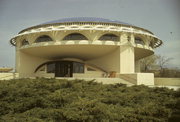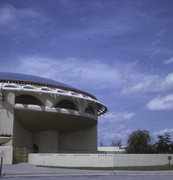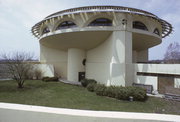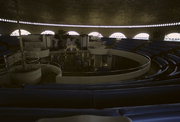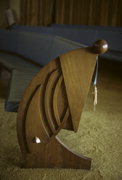Property Record
9400 W CONGRESS ST
Architecture and History Inventory
| Historic Name: | Annunciation Greek Orthodox Church |
|---|---|
| Other Name: | |
| Contributing: | |
| Reference Number: | 8918 |
| Location (Address): | 9400 W CONGRESS ST |
|---|---|
| County: | Milwaukee |
| City: | Wauwatosa |
| Township/Village: | |
| Unincorporated Community: | |
| Town: | |
| Range: | |
| Direction: | |
| Section: | |
| Quarter Section: | |
| Quarter/Quarter Section: |
| Year Built: | 1959 |
|---|---|
| Additions: | 1961 |
| Survey Date: | 1995 |
| Historic Use: | house of worship |
| Architectural Style: | Usonian |
| Structural System: | Masonry |
| Wall Material: | Concrete |
| Architect: | Frank Lloyd Wright |
| Other Buildings On Site: | |
| Demolished?: | No |
| Demolished Date: |
| National/State Register Listing Name: | Annunciation Greek Orthodox Church |
|---|---|
| National Register Listing Date: | 12/19/1974 |
| State Register Listing Date: | 1/1/1989 |
| National Register Multiple Property Name: |
| Additional Information: | A 'site file' exists for this property. It contains additional information such as correspondence, newspaper clippings, or historical information. It is a public record and may be viewed in person at the State Historical Society, Division of Historic Preservation. SEE NRHP FORM [Date Cnst:-1961]. CIRCULAR-PLAN CHURCH WAS DESIGNED BY FRANK LLOYD WRIGHT IN 1956, WAS BUILT IN 1959, AND COMPLETED IN 1961. With the Greek Orthodox Annunciation Church, Wright, in one of his last buildings, created a landmark of modernist design, replacing a more traditional building (1914) on Milwaukee’s east side. Upon hearing Wright’s name a potential designer, most of those on the building committee objected to his expensive, unorthodox designs, but soon the architect won them over. Wright, whose wife Olgivanna had grown up in the Eastern Orthodox faith, expressed an appreciation for Byzantine architecture and insisted that he could capture the essence of the Greek congregants’ Old World ancestry, while making a conspicuous modern monument. Wright created a stunning building executed in cream-colored poured concrete. The church consists of a shallow dome, resting on a gently curved bowl, cradled by a giant Greek cross. It fuses two basic elements of Byzantine church architecture--the circular dome and the cruciform plan. This cross-within-a-circle motif recurs throughout, as do broad arches. One arch frames the double entry doors and stained-glass sidelights; others pierce the decorative visor ringing the church. Moreover, the dome rises above a continuous clerestory of stained-glass-filled arches, a feature seen also at the great Byzantine Church of Hagia Sophia in Istanbul. Wright was famous for flouting his clients’ directives, but in this case he pleased the church building committee by showing respect for their traditions. Nevertheless, Annunciation is aggressively modern, reflecting Wright’s late-career fascination with the geometry of the circle. (Critics have likened the design to a flying saucer or a clam.) The structural engineering is even more forward-looking, with the 104-foot-diameter dome (designed by William Wesley Peters, Wright’s son-in-law and long-time Taliesin assistant) the most marvelous engineering feat of all. The dome is completely separate from the rest of the building. Its outer rim appears to float atop a necklace of glass beads; in fact, it rides atop hundreds of thousands of steel ball bearings, immersed in grease in a steel channel that rings the top of the clerestory. This design allows the dome to expand in warm weather and contract in cold. Wright originally covered the dome in blue mosaic tiles, but these flaked and were replaced with a blue vinyl-like membrane. More Wrightian innovations await inside. The basement accommodates a round banquet hall opening to a low classroom wing, which terminates in a chapel with a stepped, football-shaped dome. The spectacular upper level consists of a two-story, eight-hundred-seat auditorium, cupped by the bowl beneath and the dome above. On the ground level, the Greek-cross-shaped auditorium seats worshippers in three of the cross’ arms, while the chancel and altar occupy the fourth. Upstairs, the circular balcony and organ are lit by stained-glass clerestory lights, and light also filters through the ring of glass balls just beneath the dome. Spiral staircases, wrapped around light trees, link the two auditorium levels and the basement. This unusual auditorium nevertheless suits the congregants’ liturgy and traditions. The east-pointing sanctuary is typical of Greek Orthodox churches. On the prominent iconostasis (sanctuary screen), Wright again mixed new and old. The screen is a gold-anodized aluminum grille, repeatedly pierced with an abstract cross-in-circle motif; originally stylized icons painted by Eugene Masselink, an artist and secretary to Wright, hung from the screen, but those paintings are in storage. Annunciation’s priest commissioned a Greek artist to render more traditional icons in the 1990s. The change reflects the tension between tradition and innovation, although Wright tried to reconcile the two. Other modifications reflect the same tension. The original chancel railing, repeating the cross-in-circle form, has been removed. Masselink’s designs for the stained-glass clerestory windows were passed over in favor of more traditional ones, executed by Helen Hickman of Conrad Schmitt Studios and installed in 1978. And a cross (which, Wright’s defenders argue, unnecessarily repeats the church’s Greek-cross plan) now rises from the top of the dome. Wright would have objected strenuously to the changes, as do some members of the congregation. Despite these disagreements, Annunciation continues to connect its congregation’s traditions and their Midwestern home. |
|---|---|
| Bibliographic References: | Cited Perrin 67, 126-128. Wright stated the chruch was inspired by the Byzantine church Hagia Sophia. Buildings of Wisconsin manuscript. Frank Lloyd Wright Wisconsin Heritage Tour Guide |
| Wisconsin Architecture and History Inventory, State Historic Preservation Office, Wisconsin Historical Society, Madison, Wisconsin |

